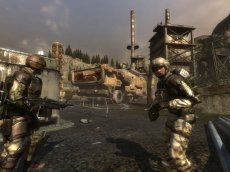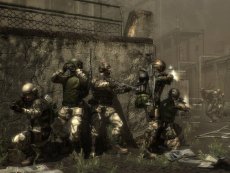With such expansive terrains it's likely that you're using a LoD system for models. If this is true, have you encountered any problems getting the same bumpmap working correctly across all LoDs? Shadow volumes are also very fill-rate hungry, and the potential for pathological use of the stencil buffer seems high; are you limiting shadow volumes by distance?
We do have a LoD system for geometry, though not for the terrain. We found that, with the size of our levels, brute-force rendering of the terrain is as fast if not faster than spending CPU time trying to cull or regenerate triangle data
For meshes, we did have some initial problems with normal maps not being suitable for different LoD levels, but our artists have discovered multiple ways of either avoiding these problems or hiding them.
We don’t have any specific LoD for stencil shadows, but a lot of our meshes do have a low-detail shadow hull to simplify their silhouettes. Some of the lowest LoD stages entirely drop the shadow hull surface, resulting in no shadow at all. This usually happens so far away though that there is no discernable visual impact.
In previous interviews you've mentioned that you have implemented HDR bloom. Could you detail the solution you've come up with? For instance, are you using FP16 blending, will it allow the use of anti-aliasing?
We do have bloom effects, but we don’t actually use HDR. When rendering the world, we use the alpha channel of the frame buffer to store a glare intensity factor. For example, places where specular highlights occur will end up with a higher intensity value as well. Our post-processing step generates a blurred version of the view. The intensity information in the alpha is then used during the post-processing step to determine the strength of the bloom rendering.
The end result of this bloom effect is visually very pleasing, our art team is definitely happy with it, and we get exactly what we want from it on all our supported target hardware. While using true HDR would help with some precision issues here and there, the memory and speed tradeoffs (as well as the lack of availability of the whole required feature set on older hardware), just don’t make it worthwhile just yet.
Some screenshots show soft shadowing under the trees. Are you using shadow maps for this or the texture projection capability of DOOM 3? If the later, will these shadows still be compatible with dynamic day/night cycles?
As several people already deducted from our screenshots, the tree shadows aren’t actual shadows in that sense. They are projected textures using a special shader and a carefully setup projection. While we do end up with some double shadowing issues, they look really convincing as they interact with any light receiving object in the game.
We’d like to thank Arnout van Meer for answering our questions as well as Matt Wilson of Splash Damage and Neil Wood of Step 3 for making this short Q&A possible during the frantic pre-E3 time. Enemy Territory: QUAKE Wars is scheduled for release in 2006 for the PC.
- If you wish to comment on this article please do so here.


